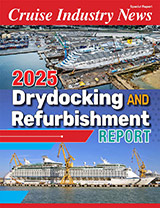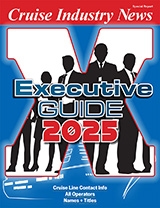With fuel costs continuing to rise, analysts are revising earnings estimates and price targets downward. At press time, the average 12-month price target for Carnival Corporation was $47.36 and the average earnings forecast per share was $3.00. For Royal Caribbean, the corresponding numbers were $41.26 and $2.85.
Dramatic Rise
How dramatic the rise in fuel prices have been can be illustrated by the fuel costs as reported by the cruise lines on a per passenger day basis. For Carnival’s first fiscal quarter of 2008, the company spent $26.54 on fuel fleet-wide, per passenger, per day, compared to $16.49 in the same quarter last year, $17.21 in 2006, and $11.06 in 2005. Beyond that, the cruise line did not report fuel costs in its quarterly or annual statements.
Royal Caribbean reported $23.92 spent on fuel per passenger, per day, in the first quarter of this year, compared to $19.45 last year, $20.22 in 2006 and $12.32 in 2005.
Royal Caribbean’s power plant mix is different, with more ships having gas turbines, which are now supplemented with diesel engines. The turbines burn the more expensive marine gas oil.
At press time, bunker fuel prices per metric ton were listed at $608 for IF0380, $649 for IFOl80,$1, 168.50 for marine diesel oil, and $1, 168.50 for marine gas oil in Rotterdam.
To mitigate the increased fuel costs, the cruise lines have reduced their fuel consumption with technology and by adjusting sailing times and itineraries. In addition, they are charging fuel surcharges.
Carnival’s North American brands charge $9 per person, per day, for the first two passengers in a cabin and $4 per person for the third, fourth and fifth persons. Royal Caribbean’s North American brands charge $8 per person, per day, for the first two passengers and $3 per person for additional people sharing the cabin. The charges are limited to $112 per person for first two passengers and $42 per person for the additional passengers. NCL charges $11 per person per day for the first two passengers and $5 for additional passengers in a cabin for bookings made after June 20.
Fuel Cost Recovered?
If 2005 is used as the base year for comparison with fuel at $11.06 per passenger, per day, for Carnival and $12.50 for Royal Caribbean, allowing for inflationary forces, today’s cost would be approximately $13 for Carnival and $15 for Royal Caribbean, compared to actual Q 1 costs of $26.54 and $23.92, respectively.
By adding the current fuel surcharges, the companies are recovering some of the additional cost. A rough estimate leaves Carnival with $4 in fuel costs per passenger, per day, above and beyond what fuel should have cost and with the surcharges factored in. For Royal Caribbean, the corresponding number would be $2.
Some cruise lines may swing the surcharge to greater benefit. Oceania Cruises charges $15 per guest, per day, for the first two passengers in a stateroom, for reservations made after June 16. The fuel surcharge will be charged per person for any length of cruise, although there is no fuel surcharges for additional passengers in a cabin.
Per Passenger, Per Day
The fuel cost comparisons are made complicated by the continuous introduction of new ships, fuel savings efforts and even changing power plants. In addition, Royal is also hedging about 50 percent of its consumption. Hence, Cruise Industry News finds it reasonable to compare costs on a per passenger, per day, basis. As such, Carnival has seen a 140 percent increase since 2005, and Royal Caribbean has seen an 85 percent increase.
ln Q 1 2008, fuel costs were 18 percent of Carnival’s operating costs, compared 13 percent in 2007, 14 percent in 2006, and 9.5 percent in 2005. For Royal Caribbean, fuel costs were 16.4 percent of operating costs in 2008, compared to 14 percent in 2007, 15.4 percent in 2006 and 10 percent in 2005.
Broader Impact
On a broader scale, increased fuel prices are also affecting the costs of foods and beverages and other provisioning of the ships, including transportation to the ships.
Passengers are also affected in their daily lives and when travelling to the ships. Airfares are going up; some flight schedules have been reduced; and some airlines have started to charge extra for luggage. The bottom line is that the average consumer is being squeezed with a higher cost of living, while the cost of a vacation, including a cruise, is going up. At press time, Carnival’s shares were listed at $36.06, down from $43.59 at the start of the year, for a 17 percent drop. Royal Caribbean was listed at $25.50, down from $40.97 at the beginning of the year, for a 38 percent drop.



